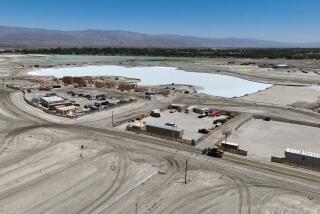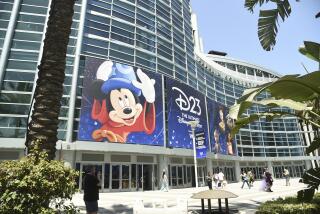A Key Question: Who’s Going to Pay? : Financing: Disney hopes Anaheim, the state and the U.S. will cover a total of $800 million in costs. Some of the money is committed, some not.
- Share via
ANAHEIM — Now that they know what they want to see built, Anaheim and the Walt Disney Co. have to decide who will pay for it.
Disney plans to spend $2.2 billion creating the most elaborate resort in California, a labyrinth of wonders displayed in a lake-laced, international-theme park dotted with fancy hotels.
But the environmental blueprint endorsed Tuesday by the City Council also calls for surrounding the resort with palm-lined boulevards, cavernous parking garages, improved sewers and storm drains. Disney expects government agencies to provide an estimated $800 million in public works and other improvements to make urban Anaheim look and work more like suburban Irvine.
Forty years ago, Walt Disney asked little of Anaheim when he broke ground for his Magic Kingdom amid the orange groves along Harbor Boulevard. He cashed in a life insurance policy and sold his Palm Springs house to help pay for his dream.
But his successor, Disney Chairman Michael D. Eisner, has labeled the proposed Disneyland Resort a risky business proposition that his company refuses to do alone. Either government steps in and contributes or, he has warned, the project won’t be built.
While some cities might blanche at a request for hundreds of millions of dollars in public financing to benefit a privately owned project, Anaheim sees the Disneyland Resort as a cash cow and the best way to renovate the commercial clutter that encircles the present park.
A major effort has been made by city, county, state and federal officials to support the project. Some of the $800 million is committed, but much of the financing has yet to be settled. Once federal, county and state agencies have weighed in, it will be up to the city of Anaheim to decide whether it can finance the balance, which could be as much as $500 million to $600 million.
Here are the major components of the $800 million in projects that Disney wants financed by the public:
* Parking: Disney wants to build two main parking structures, believed to be the largest in the United States. On the west side of the theme park, a 16,700-space structure would have to be financed by the city, most likely through the sale of insured municipal bonds. On the east, the Orange County Transportation Authority has sought federal funding to develop the garage as a commuter bus station--and split the balance of the cost among the city, state and county agencies. Total cost of both structures would be about $450 million.
* Off-ramps: Two ramps from the Santa Ana Freeway would feed into the parking structures. The city and the state are planning to split the $50-million cost.
* Street landscaping: All those date palms come at a price, but the city and Disney say they don’t know the cost yet. The plantings would most likely be paid through the same bond deal the city would use to build the parking garages. But city officials say they are talking about asking property owners in the area surrounding Disneyland to allow for creation of an assessment district to pay for the added costs of landscape maintenance. The added cost would be tacked onto property tax bills.
* Utility lines: The ugly overhead power lines that stretch across the Disneyland parking lot will be buried, along with just about every other utility line in the area. The city has a special fund set aside to relocate lines underground. An undetermined amount of money will have to be found, however, to pay for burying those owned by Southern California Edison and other utilities.
* Storm drains: The city is thinking of forming another assessment district to improve storm drainage not only around Disneyland but in much of the rest of the central city. Interestingly, Disneyland would probably be partially exempt from having to pay into the district; its expansion plans call for runoff to stream into the park’s own lakes instead of the public drainage system.
There is little mystery about why the city appears ready to take a gamble with Disney: jobs and tax revenue.
Disney is promising that the project will create 17,500 jobs in the city when it is complete in 1998. In addition, construction work will be plentiful during development.
The city estimates that by 2008 it will be earning $36 million more annually in taxes and fees than the $14.6 million it would take in without the project. And city officials insist that they are taking a hard line in negotiations with Disney, and may refuse to shoulder as much of the cost as Disney would wish.
The city has three basic ground rules: prevent any risk to the main pot of city money that pays for such basic services as police and fire protection, insure the bonds in case the project fails, and be sure there is a net gain in revenue after all the bonds and other costs of increased services are paid.
Even with those rules, the project doesn’t sit well with some.
Steve White, an Anaheim realtor and former redevelopment commissioner, has argued that city funds are going to be far more exposed than officials are willing to admit. The city’s own estimates show that its revenue from Disney and the tourism around it will be depressed every year until the Disneyland Resort opens in 1998.
Revenue aside, White said he thinks using public money to support a private developer is just plain bad policy. The city should issue bonds for civic projects that directly offer services to its citizens, not bet on a private endeavor, said White, who recently assumed the helm of an Anaheim homeowners’ group that has opposed the project.
“Who knows,” he added, “in a few years we may be putting on ‘virtual reality’ helmets and going to all amusement parks” without ever leaving the living room.
The possible hidden costs and financial variables in the project are a worry even for some who like the development. Bob Zemel, a former planning commissioner and two-time council candidate, said, “I don’t know how they can be going forward with a plan without knowing who will be paying for it.”
While many of the costs are uncertain, Anaheim is counting on lowering its outlay by getting a little help from its friends--the Transportation Authority and the state and federal governments. And the lobbying has been furious.
State trade chief Julie Wright took a personal interest in the project after Eisner gave a speech last year in Orange County blasting the state as anti-business. She considers the project crucial to feeding the state’s $54-billion tourism economy and has been a key lobbyist for it in Washington and Sacramento.
“The Disneyland Resort is one of the premier economic development projects in the United States, both in terms of level of investment and in number of jobs,” said Wright, who is Gov. Pete Wilson’s trade and commerce secretary.
So far, the biggest chunk of non-Anaheim money has come through the Orange County Transportation Authority. Instrumental was lobbying by its chief executive officer, Stan Oftelie, who discovered that the proposed east parking structure would be near a long-forgotten site for a commuter bus station. Why not, he asked, combine the two and seek federal funds for it?
“It was serendipity,” he said.
Disney officials were at first hesitant, but were won over by state and OCTA officials who argued that the parking structure could work for commuters as well as tourists.
The coordination among agencies reached full boil earlier this year when Wright joined state Department of Transportation and Disney officials on a trip to Washington. The lobbying bore fruit Tuesday, when the House Appropriations Committee approved funds for the first year of its expected $131-million commitment to the garage.
But the rest remains unfunded.
The fluid financing situation mirrors the bargaining going on among the principals, Anaheim and Disney. The two will have to settle these questions in a development agreement that is supposed to spell out who pays how much.
Disney will have its chance to opt out too. The company will need to decide, once the development agreement is complete and all other government agencies have weighed in, whether to build the project.
Who’s Going to Pay?
Walt Disney Co. would pay most of the $3-billion Disneyland expansion bill. But the city of Anaheim and state and federal governments are being asked to contribute significantly. A look at how the resort would probably be financed. All amounts are estimated, in millions unless otherwise noted.
Disney share / Westcot Center, Resort hotels, Disneyland Hotel refurbishment: $2.2 billion Government share: $800 million (Figures in millions) Government share East parking structure*: $203 Federal: $131 Anaheim, OCTA: $37 State: $35 Disney will also contribute $20 million West parking structure, Anaheim: $227 Two I-5 off-ramps / Total: $50 Anaheim: $25 State: $25 Other Public Works, Anaheim (including landscaping, sewers, storm drains, utility line relocation, etc.): $320 Sources: City of Anaheim, Times reports
More to Read
Inside the business of entertainment
The Wide Shot brings you news, analysis and insights on everything from streaming wars to production — and what it all means for the future.
You may occasionally receive promotional content from the Los Angeles Times.










